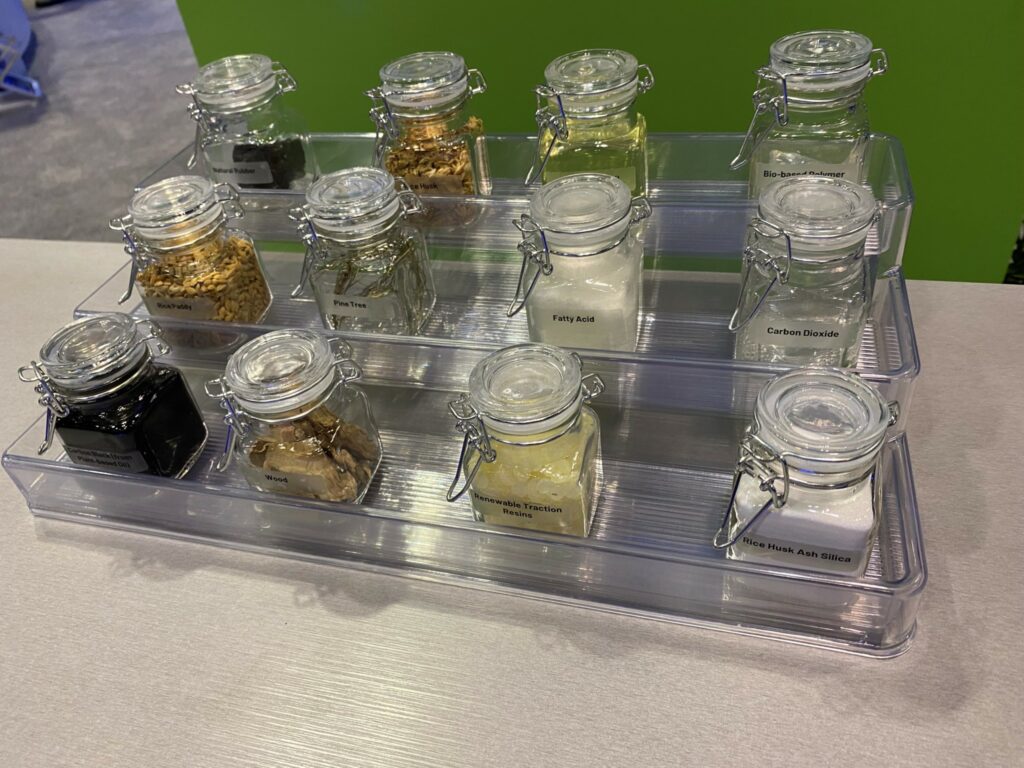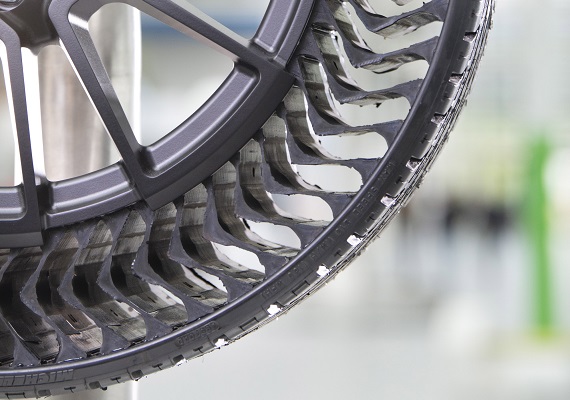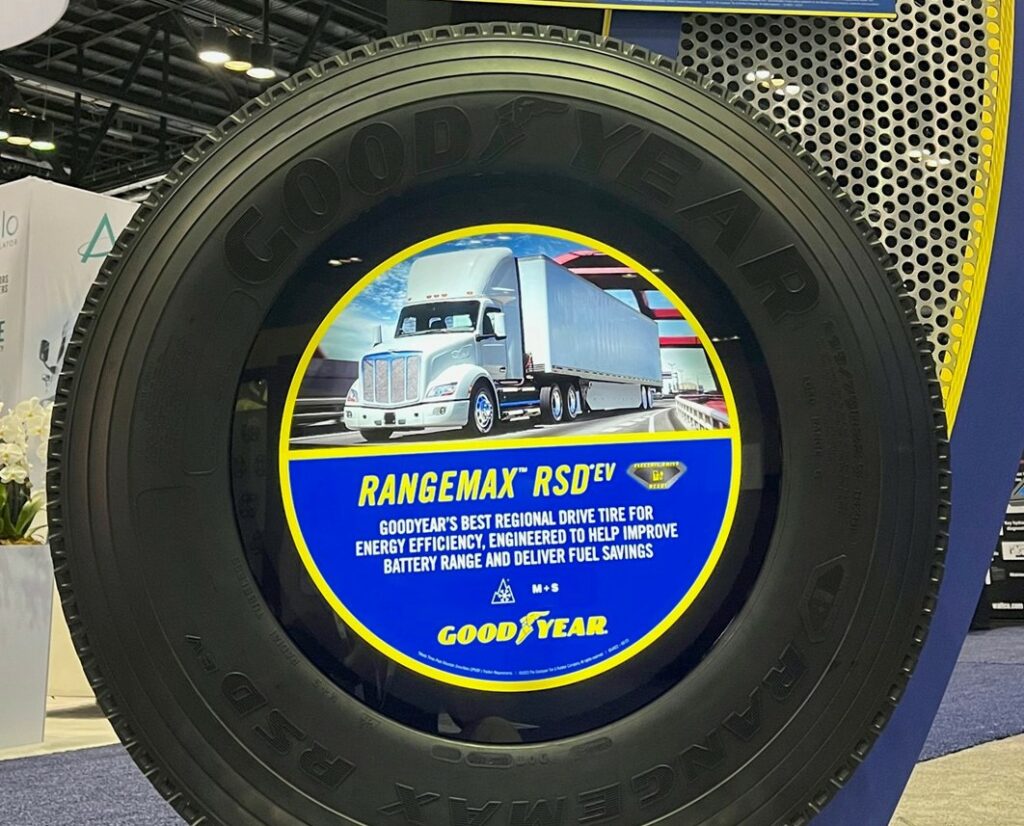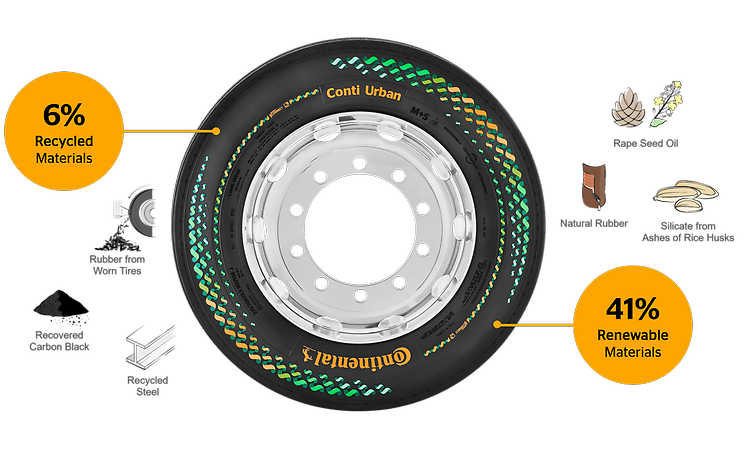Sustainable tires growing like weeds, particularly dandelions
Dandelions. Rice husks. Soybean oil. Sounds like the trappings of an entrée at a fancy vegan restaurant.
But these are some of the ingredients that will likely go into future tires as the truck tire industry looks to reduce the environmental impact of its products. Truck manufacturers are under immense pressure to decarbonize, and that can’t be done without some attention given to the big round rubber components that connect them to the asphalt.
Future tires may always look as they do today – round and black – but what goes into making them is likely to change drastically. Jessica Julian leads product marketing for Goodyear Tire & Rubber. She told TruckNews.com that in one concept truck tire, a red Solo cup of soybean oil has replaced the petroleum that would go into a traditional truck tire.
“They take out the petroleum and replace it with a smaller amount of soybean oil to still get the same performance,” she explained. But you won’t find fully sustainable tires on the market soon. More work must be done to validate their performance. That work, however, is already well underway.

New ingredients
Goodyear’s sustainable commercial tire incorporates 15 sustainable elements across 20 components within the tire. They include soybean oil, rice oil, rapeseed oil and ash.
“Our learnings are in these demonstration tires,” Julian said, gesturing to a display at the Technology & Maintenance Council’s spring meeting earlier this year. “How can we take what we’ve learned here and incorporate these into other tires in our portfolio?”
Continental Tire sees dandelions as a replacement for natural rubber in its future tires. While natural rubber, derived from the rubber tree, is itself renewable, the rubber tree must grow for seven years before it begins to produce the latex needed for rubber production. And its growth is limited to a small geographic slice of the world. As a result of its long lifecycle and precise growing conditions, demand for natural rubber outpaces the availability. Between 10-30% of a car tire includes natural rubber, with truck tires requiring “proportionally higher amounts,” according to the company.
That’s where Continental sees dandelions as an alternative. Anyone with a yard to care for knows how quickly these pesky weeds can grow and reproduce. Continental has already built and tested car tires with treads made fully of natural rubber derived from dandelions, and plans to begin rolling them out commercially in five to 10 years. But before you begin collecting dandelions from your yard, keep in mind a special breed of Russian dandelion is required.
The roots of that specific plant contain the natural rubber latex that can be used in tire production. It has less sensitivity to weather than the rubber tree, and because of a shorter lifecycle it will give tire makers more consistent supply and price stability.
“In agricultural terms, dandelions are an undemanding plant, growing in moderate climates, even in the northern hemisphere, and can be cultivated on land not suitable for food production,” said Carla Recker, who heads the Continental team leading the project. “This means that rubber production is conceivable near our tire factories, for instance, and the significantly shorter transport routes would also reduce CO2 emissions.”

The main ingredient in a tire is, of course, air. Michelin is even exploring ways of removing that from the equation. While air isn’t harmful to the environment, an airless tire is less likely to fail, producing roadside scrap. First revealed at its Movin’ On sustainability conference in Montreal in 2017 in a passenger car size, the Vision tire was made completely of biosourced materials. Michelin predicted the airless design would be viable within 10-15 years.
Some of its ingredients included orange peels, cardboard, used metal, molasses, and other waste material. It featured a rechargeable tread that can be changed when plugged into a device that uses 3D printing to reconfigure the tread design. Imagine being able to change your tires’ tread for weather or route conditions.
“It’s a very realistic dream,” Terry Gettys, executive vice-president — research and development with Michelin Group said at the time. “All the components are currently the topics of active research programs at Michelin and we can deliver on those solutions.”
Tires for electric vehicles
But in the more immediate future, as the push toward zero emissions transport ramps up, so too does the uptake and interest in battery-electric trucks. Not surprisingly, some tires targeting this specific application are beginning to hit the market. Earlier this year, Goodyear introduced the RangeMax RSD regional drive tire – billed as its first regional drive tire for electric trucks.
Goodyear denotes the tire with an “Electric Drive Read” designation. But the main attribute that makes it suitable for EV applications is its low rolling resistance, which is equally beneficial on diesel-powered vehicles.

When it comes to urban buses, tires must be reengineered to account for thousands of pounds of additional battery weight. That’s not the case with truck tires, which are already designed to carry much heavier gross vehicle weights. While some jurisdictions grant a slight additional weight allowance to EVs, that’s not enough to put undue pressure on the truck tires. So, the focus is on reducing rolling resistance, which in turn extends battery range – or for that matter, the range of a tank of diesel fuel.
So, while designated as an EV tire, Goodyear’s RangeMax RSD can be put into service on a diesel-fueled truck, no problem.
“The ultra-low rolling resistance is going to help give you that extended battery range, just like it does for fuel range,” Julian said in an interview.
Some other tire manufacturers, however, such as Michelin, don’t differ between their low rolling resistance models for EVs or internal combustion engine vehicles. B2B product category manager Mike Tolman, explained that lower rolling resistance “is the X factor” when it comes to EVs. And earlier this year, Michelin introduced its lowest rolling resistance tire to date, the X Line Energy Z+.
While not specifically designated for EVs, it was developed as part of Daimler Truck North America’s Department of Energy-funded SuperTruck II project, and its attributes – specifically low rolling resistance – will suit the range-extending needs of EV fleets, as well as those running traditional diesels.
Recycling & retreading
The recycling of tire casings is widely done today through use of retreads. But more can be done to prevent used tires from entering landfills. Continental is practicing what it preaches in terms of used tire recycling. By 2025 it plans to eliminate tire waste within its own channels.
That means “zero tires going into landfill from our stores, and our company owned factories, by 2025,” Saun Uys, head of Continental U.S. market – truck tires replacement, told TruckNews.com in an interview. “The equivalent weight [of tires] that we sell, we will connect back for the pyrolysis process.”
What is pyrolysis? It’s a thermal decomposition process used to break waste tires back down into raw ingredients such as carbon black and steel that can be used to create new tires.
“Through the pyrolysis process, we get recycled materials — recycled steel and worn shavings,” explained Uys. But he hastened to add the process is still expensive and costs must come down for it to become more widely utilized.
At the fleet level, retreading is the best way to minimize the environmental impact of your tires.
“Retreading is a renewable energy source,” Uys said. “You can lower your fleet cost, and there are also massive environmental impacts.”
According to Bandag, a truck rolling on 18 retreads saves enough manufacturing energy to power 482 homes for a day. Digging deeper into the environmental benefits of retreading, Bandag calculates it reduces: CO2 emissions by 24%; natural resource extraction by 24%; water consumption by 19%; air pollution by 21%; and resource land use by 29% (all compared to using virgin replacement tires). Fleets that run retreads can incorporate these initiatives into their environmental, social and governance (ESG) reports, while also reducing costs.

Have your say
This is a moderated forum. Comments will no longer be published unless they are accompanied by a first and last name and a verifiable email address. (Today's Trucking will not publish or share the email address.) Profane language and content deemed to be libelous, racist, or threatening in nature will not be published under any circumstances.